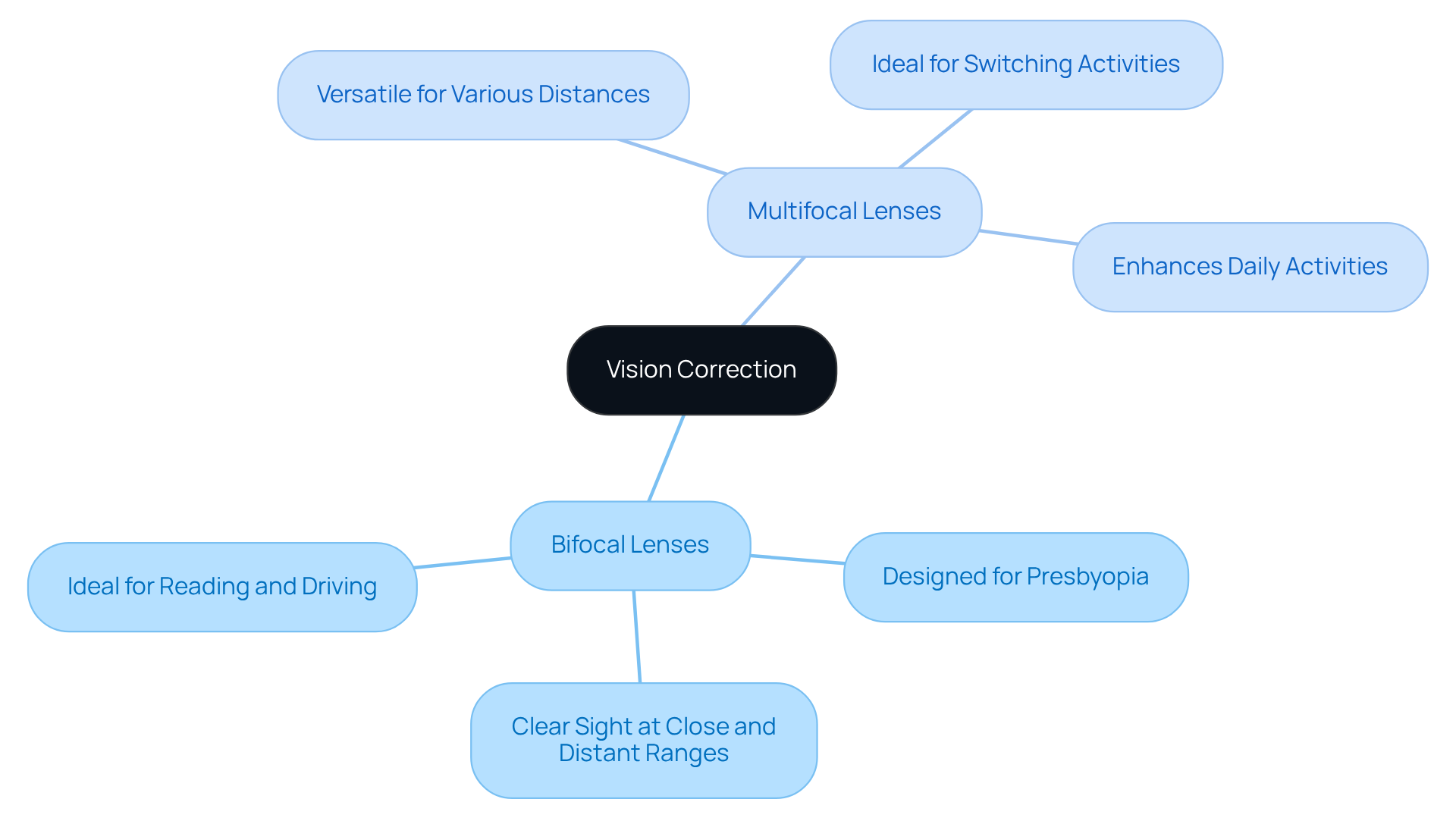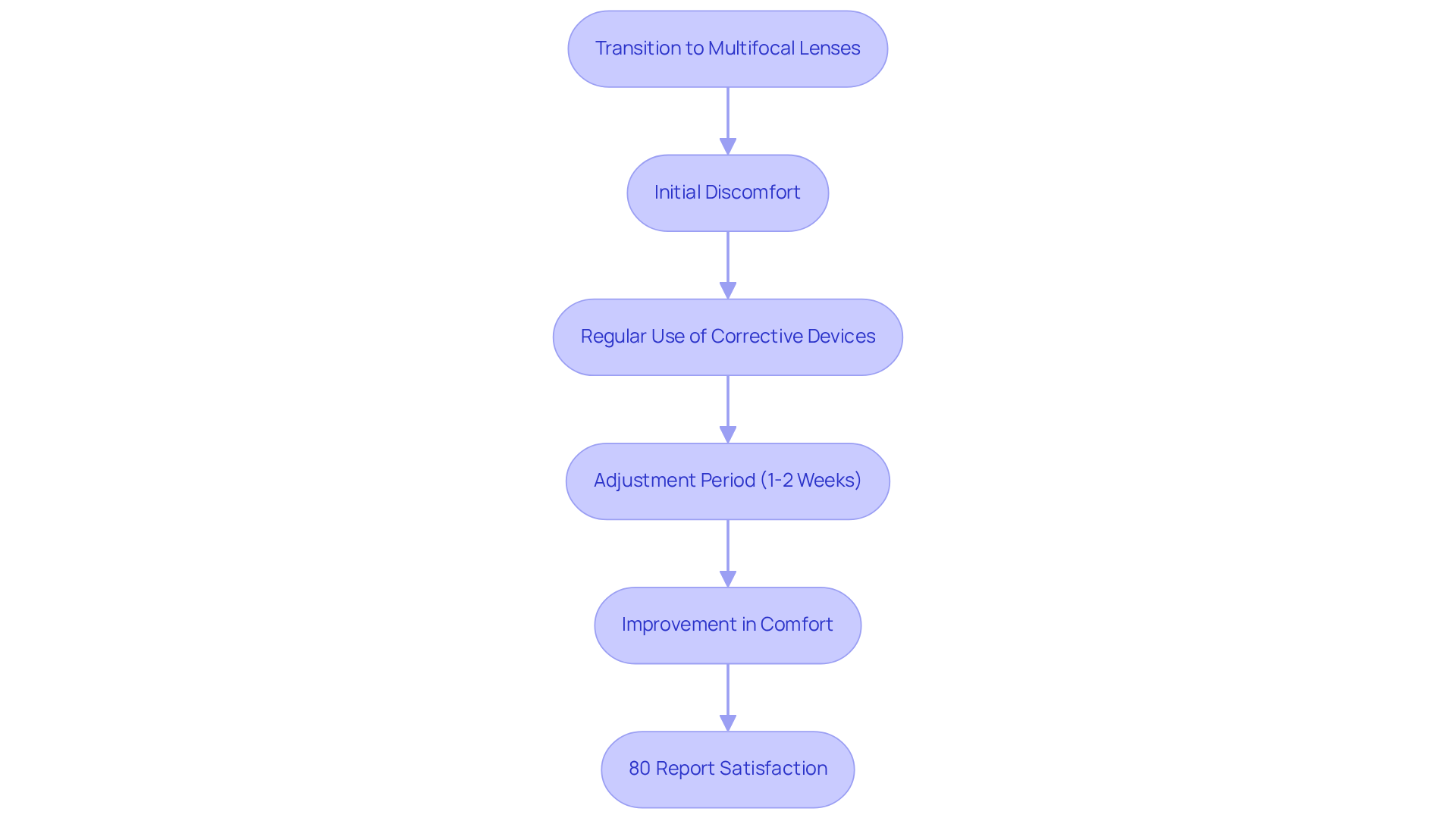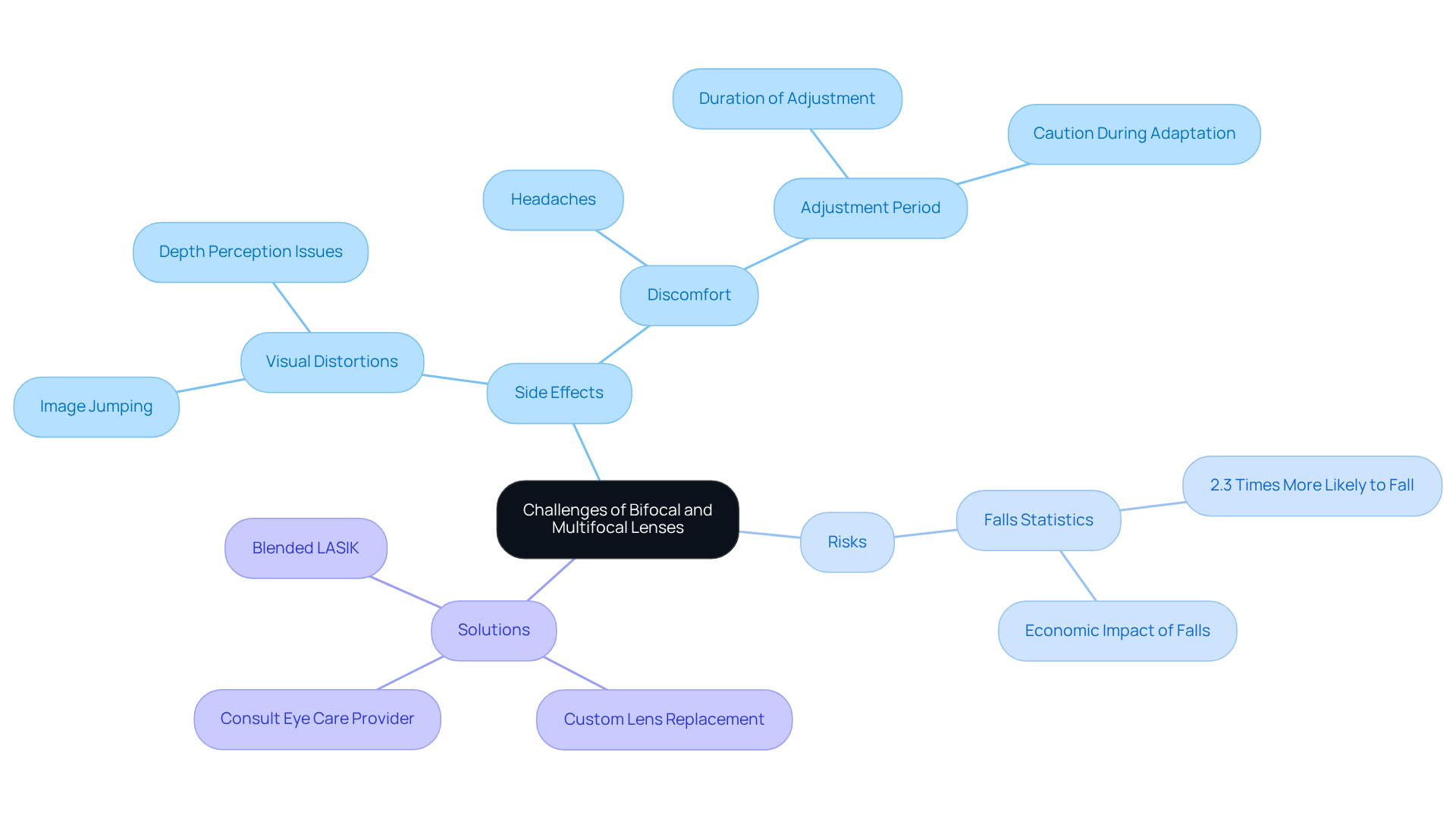Posted by: Northwest Eye in General on June 20, 2025
Overview
This article offers seven key insights into bifocal lenses, highlighting their thoughtful design, numerous benefits, and the latest advancements in technology that aim to improve vision correction.
We understand that navigating the differences between bifocal and multifocal lenses can be overwhelming.
It’s common to feel uncertain during the adjustment period for new users, but rest assured that recent innovations are designed to enhance both comfort and clarity.
By providing this information, we hope to support you in making informed decisions about your vision care.
Introduction
Navigating the world of vision correction can feel overwhelming, especially for those experiencing age-related changes in their eyesight. We understand that finding the right solution is crucial for your daily life. Bifocal and multifocal lenses present distinct options, each tailored to meet the unique needs of individuals seeking clear vision at various distances. In this article, we explore seven key insights that highlight the benefits, challenges, and advancements in lens technology. Our goal is to equip you with the knowledge needed to make informed choices. But with so many options available, it’s common to wonder: how can you determine which lens type truly enhances your visual experience? We are here to help you through this process.
Northwest Eye: Expert Guidance on Bifocal and Multifocal Lenses
At Northwest Eye, we truly understand that navigating your vision care can be overwhelming. Our team of skilled ophthalmic surgeons is here to provide expert advice on bifocal lenses and progressive options, ensuring you feel supported every step of the way. With over 50 years of dedication to eye care, we guarantee that you will receive customized attention tailored to your unique sight requirements.
Our surgeons specialize in innovative techniques, including the use of Light Adjustable Lenses. These advanced options enhance the effectiveness of bifocal prescriptions and multifocal prescriptions, providing you with greater clarity at different distances. We want you to feel confident in your choices, which is why we emphasize patient education. It’s common to have questions, and we are here to assist you in comprehending the advantages of these advanced optics.
We invite you to explore how these solutions can improve your vision. Remember, we are here to help you through this process, ensuring you receive the care and understanding you deserve.
Lens Design: Distinct Features of Bifocal vs. Multifocal Lenses
Bifocal glasses feature two distinct optical areas, with the upper part designed for distance vision and the lower portion catering to close sight, clearly separated by a visible line. In contrast, progressive lenses offer a smooth transition between multiple focal points, allowing for clear vision at various distances without any noticeable lines. This seamless design is especially beneficial for individuals needing correction for both near and far vision, enhancing visual comfort and reducing the necessity for multiple pairs of glasses.
We understand that choosing the right eyewear can be overwhelming. Practical experiences from many patients reveal the advantages of modern eyewear; numerous individuals report a smoother visual experience and greater satisfaction when compared to traditional bifocal lenses. Optometrists often recommend progressive lenses due to their ability to provide a more natural visual experience, enabling users to shift focus effortlessly between different distances. Recent advancements in optical design have further improved the performance of multifocal optics, incorporating innovative materials and technologies that enhance clarity and comfort.
It’s common to feel uncertain about which type of eyewear is best for you. Understanding these differences can empower you to select the eyewear that best aligns with your lifestyle and visual needs. We are here to help you through this process, ensuring you find the perfect solution for your vision.

Vision Correction: How Bifocal and Multifocal Lenses Serve Different Needs
Bifocal lenses are thoughtfully designed for individuals with presbyopia, allowing for clear sight at both close and distant ranges. They are especially beneficial for everyday tasks like reading and driving. In contrast, multifocal products address a wider range of sight needs by providing sharpness at various distances, including intermediate areas. This versatility makes them ideal for those who frequently switch between activities that require different focal lengths, such as using a computer and reading while also needing to see across a room.
We understand that vision changes can be concerning. Statistics reveal that approximately 1 in 8 individuals over the age of 50 in the U.S. experience presenting near vision impairment (PNVI), highlighting the significant demand for effective vision correction solutions. Furthermore, research shows that removing certain types of eyewear can decrease fall risks by as much as 40% among active individuals, underscoring the importance of selecting the right glasses for both safety and functionality.
Patients have reported remarkable enhancements in their daily activities after transitioning to multifocal options. For instance, individuals who once struggled with reading fine text or focusing on distant objects have found that specialized eyewear allows them to perform these tasks effortlessly. Eye care specialists emphasize the benefits of these optical devices, noting that they not only enhance visual sharpness but also improve quality of life by reducing the need for multiple pairs of glasses.
It’s important to recognize that the global unmet need for presbyopia correction was estimated at 45% in 2015, indicating a significant gap in access to effective solutions. The economic impact of uncorrected presbyopia is also noteworthy, with potential productivity losses reaching $11 billion for those aged 50 and younger.
Understanding the differences between bifocal options and multifocal options is essential for making informed choices that align with your unique lifestyle and visual needs. As Dr. Komal Patel notes, ‘Every patient has different visual needs, whether it involves requiring the dreaded bifocals or having to take glasses off to read the newspaper.’ This highlights the necessity for customized eyewear options that cater to diverse activities. We are here to help you through this process, ensuring you find the right solution for your vision needs.

Adjustment Period: Transitioning to Multifocal Lenses
Transitioning to multifocal eyewear can be a journey that requires some adjustment, typically lasting from several days to a couple of weeks. We understand that during this time, you may experience visual changes, such as unclear sight or headaches, as your eyes adapt to the new design. This adjustment is particularly important for those considering the innovative Light Adjustable Lens (LAL) technology, which allows for customizable adjustments post-surgery, enhancing your overall vision correction experience.
Regular use of your corrective devices is vital during this stage, as it helps facilitate the adjustment process. We encourage you to exercise patience and follow your eye care professional’s advice to improve comfort and achieve optimal visual clarity. It’s common to feel a bit uneasy initially; statistics show that after 1-2 weeks of consistent use, around 80% of patients report satisfaction with their progressive eyewear, highlighting the effectiveness of this adjustment phase.
Many users share their experiences, noting that while initial discomfort is typical, it usually resolves as your brain learns to select the appropriate prescription zone for different distances. If discomfort persists beyond a few weeks, we recommend consulting your eye doctor to ensure proper fitting and prescription adjustments. Understanding unclear sight, which can stem from various conditions, is crucial during this learning curve, as it can impact your adaptation process.
This learning curve is essential for maximizing the benefits of bifocal eyewear, allowing you to enjoy clear sight at all ranges without the need to switch glasses. Remember, we are here to help you through this process, and your comfort is our priority.

Side Effects: Understanding the Challenges of Bifocal and Multifocal Lenses
While bifocal and multiple vision optical devices provide significant benefits, we recognize that they can also pose challenges. Many patients experience common side effects such as visual distortions, including image jumping or difficulty with depth perception, especially when transitioning between different focal zones. It’s not uncommon to feel discomfort or headaches during the adjustment period, which can last a couple of weeks.
Statistics reveal that older individuals wearing multifocal eyewear are 2.3 times more likely to experience falls compared to those using single-vision eyewear. This highlights the potential dangers associated with these glasses. The economic impact of falls is substantial, with healthcare costs related to fall injuries reaching billions annually.
It’s crucial to communicate any ongoing issues with your eye care provider. They can offer solutions or adjustments to enhance your comfort and visual clarity. Additionally, exploring options such as Custom Lens Replacement or Blended LASIK may provide effective alternatives for those struggling with bifocal lenses.
Proper fitting and regular follow-ups are essential to reduce discomfort and improve your overall visual experience. Remember, an improper fit can lead to distractions from the frame’s rim in your peripheral vision. We are here to help you through this process and ensure you find the best solution for your needs.

Professional Fitting: Ensuring Comfort with Bifocal and Multifocal Lenses
A professional fitting is essential for enhancing the comfort and performance of bifocal eyewear as well as multifocal eyewear. We understand that finding the right fit can feel overwhelming. Vision care experts evaluate various elements, including your pupillary distance, frame choice, and specific visual needs, to ensure the glasses are positioned perfectly for you. With an appropriate fitting, you can reduce the chance of discomfort and visual distortions, allowing you to fully enjoy the benefits of your eyewear.
Statistics indicate that success rates for bifocal contact lenses vary from 67 to 83 percent, especially among older individuals who have worn contacts for years. It’s common to feel a bit uncertain during the adjustment period for bifocal lenses, which typically lasts one to two weeks but may extend to four to six weeks for some. Regular follow-ups with your eye care provider can further enhance the fitting process and help address any concerns that may arise.
It’s also important to acknowledge potential drawbacks, such as:
- Disorientation
- Eye strain
- Headaches during this adjustment phase
Understanding the types of bifocal contacts available, such as segmented and concentric options, can give you valuable context in your pursuit of optimal comfort. Remember, we are here to help you through this process and ensure your experience is as smooth as possible.
Technological Advancements: Innovations in Bifocal and Multifocal Lens Design
Recent advancements in bifocal design and multi-vision technology have led to significant improvements in comfort, clarity, and aesthetics. At Northwest Eye, we understand that navigating changes in vision can be challenging, which is why our presbyopia package is designed with you in mind. It employs specialty optics, including accommodating, multifocal, and extended depth of focus options, to help reduce your reliance on glasses across different focal ranges.
We know how important visual quality is to you. Innovations such as digitally optimized optics enhance this quality by reducing distortions and improving peripheral vision. Additionally, new materials have made optics lighter and more durable, ensuring comfort throughout your day. Research shows that customer satisfaction with these new optical materials is exceptionally high, with presbyopia correction using contact devices representing up to 25-35% of contact device fittings in various nations.
These technological advancements not only enhance visual clarity but also cater to the lifestyle needs of modern individuals. This makes bifocal options more appealing for those experiencing changes in sight, alongside multifocal choices. As optometrist Alex Tharman observes, advancements in lens design have greatly improved comfort and visual outcomes, reinforcing the attractiveness of these lenses for those facing sight difficulties.
With options like the Light Adjustable Lens, we invite you to customize your vision correction at Northwest Eye, ensuring optimal results tailored to your specific needs. We are here to help you through this process, providing the support and care you deserve.

Conclusion
Navigating the world of vision correction can feel overwhelming, especially when considering the choice between bifocal and multifocal lenses. We understand that each option presents unique advantages tailored to individuals experiencing presbyopia. Bifocals offer a straightforward solution for clear vision at two distinct distances, while multifocal lenses provide a seamless transition between various focal points, catering to a broader range of visual needs.
Throughout this discussion, we’ve highlighted key insights into the design differences between bifocal and multifocal lenses. The importance of professional fitting cannot be overstated, as well as the adjustment period that comes with transitioning to new eyewear. Technological advancements have significantly improved comfort and clarity in lens design, making these options more appealing for those facing age-related vision changes.
Ultimately, understanding the differences and benefits of bifocal versus multifocal lenses is vital for making informed decisions about your vision correction. As the demand for effective solutions grows, we encourage you to consult with eye care professionals who can help you find the best fit for your unique lifestyle and visual needs. Taking proactive steps in your vision care not only enhances your daily activities but also significantly improves your overall quality of life.
Frequently Asked Questions
What are bifocal lenses?
Bifocal lenses feature two distinct optical areas: the upper part is designed for distance vision, while the lower portion caters to close sight, clearly separated by a visible line.
What are multifocal lenses?
Multifocal lenses, specifically progressive lenses, offer a smooth transition between multiple focal points, allowing for clear vision at various distances without any noticeable lines.
What are the benefits of progressive lenses compared to bifocal lenses?
Progressive lenses provide a more natural visual experience, enabling users to shift focus effortlessly between different distances. They enhance visual comfort and reduce the necessity for multiple pairs of glasses.
What innovative techniques does Northwest Eye use for vision correction?
Northwest Eye specializes in innovative techniques, including the use of Light Adjustable Lenses, which enhance the effectiveness of bifocal and multifocal prescriptions, providing greater clarity at different distances.
How does Northwest Eye support patients in choosing the right eyewear?
Northwest Eye emphasizes patient education and provides customized attention tailored to individual sight requirements, helping patients understand the advantages of advanced optics.
Why might someone feel overwhelmed when choosing eyewear?
Choosing the right eyewear can be overwhelming due to the variety of options available and the differences between lens types, leading to uncertainty about which type best aligns with one’s lifestyle and visual needs.
How has optical design improved recently for multifocal lenses?
Recent advancements in optical design have improved the performance of multifocal optics by incorporating innovative materials and technologies that enhance clarity and comfort.






